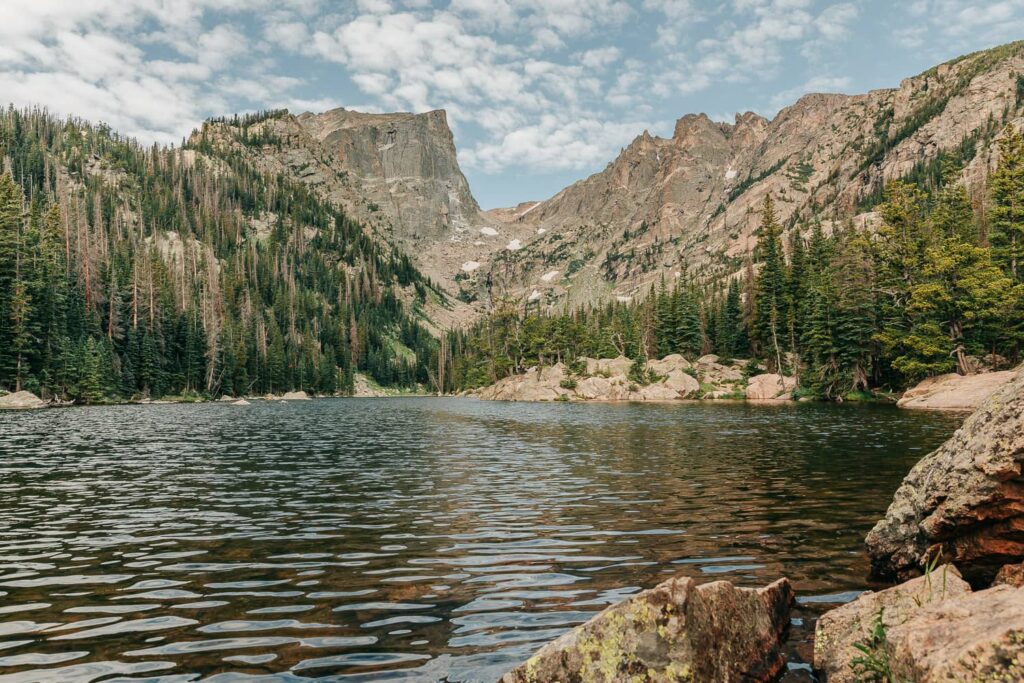
If there’s one thing Estes Park is known for, it’s the amazing hiking trails both inside and outside Rocky Mountain National Park! Estes Park has so many trails for all skill levels, seasons, and preferences.
Whether you’re spending a week in Estes Park or just an afternoon, traveling with kids, dogs, friends, or flying solo, there’s a trail that’s perfect for you. There’s also lots of beautiful views, waterfalls, and lakes in the area that you can only access by hitting the trails!
Below are some of my favorite hiking trails in Estes Park, organized by difficulty and location. I’ve also included some key information about hiking inside Rocky Mountain National Park (including how to get a timed entry permit during peak season), and how to hike safely while respecting the beautiful nature in and around Estes Park.
Easy Hikes in Estes Park
Are you limited on time, traveling with young kids, or just not adjusted to the high elevation quite yet? No worries! There are plenty of options for shorter, easier hikes and walks with limited elevation gain in Rocky Mountain National Park.
Easy Hikes in the Bear Lake Corridor
The Bear Lake Corridor is one of the most popular parts of Rocky Mountain National Park, with so many beautiful trails, lakes, and stunning views. It’s also one of the busiest parts of the park, so make sure to read the section below on timed entry permits to the Bear Lake Corridor during peak season! Below are my favorite easy hikes inside of the Bear Lake Corridor.
Sprague Lake Loop

Length: 0.8 miles
Elevation Gain: 36 feet
The Sprague Lake Loop is a 0.8-mile loop around Sprague Lake, with clear, picturesque mountain views. This trail is well-maintained and has a wooden pier with a beautiful mountain backdrop that’s a popular place for photos, and especially proposals and elopements! Sprague Lake is a great option for young kids or those with limited mobility as the trail is flat, doesn’t have any major obstacles, and has several benches along the trail (there’s even an accessible wilderness campsite here).
Bear Lake Nature Trail
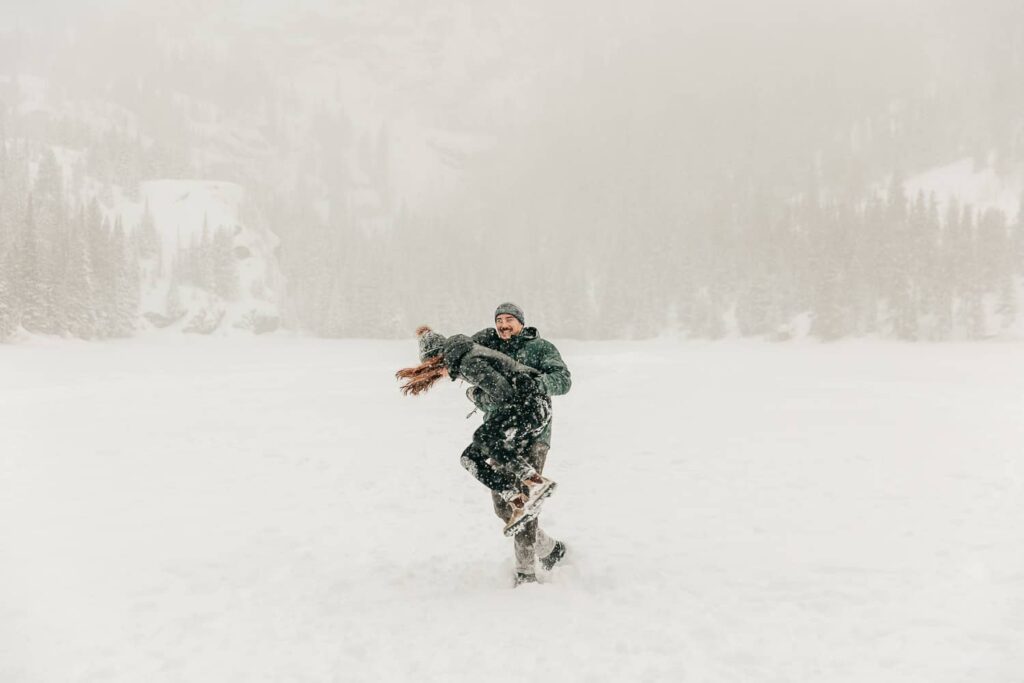
Length: 0.7 miles
Elevation Gain: 49 feet
The Bear Lake Nature Trail is a 0.7-mile loop around Bear Lake, and also marks the start of several other trails, including one of my favorites that takes you up to Nymph, Dream, and Emerald Lakes (more below). Bear Lake is surrounded by trees with views of Hallett Peak, which makes it a really beautiful spot to take in some of the unique beauty of Rocky Mountain National Park. It also freezes over in the winter for a completely different landscape!
Easy Hikes Outside the Bear Lake Corridor
The Bear Lake Corridor can be busy (for good reason!), especially during peak season, but the rest of Rocky Mountain National Park has so much to offer as well! These are some of my favorite easy, short hikes and walks throughout all of Rocky Mountain National Park.
Lily Lake

Length: 0.8 miles
Elevation Gain: 29 feet
Lily Lake is an easy 0.8-mile loop around a lake with a great view of Longs Peak, one of Colorado’s most iconic mountain peaks. This is a very well-maintained, flat, gravel and boardwalk trail that makes it a great choice for young kids or people who can’t tackle a rocky trail. You can also walk up the hill above the lake for a panorama view of the lake and mountains.
Alluvial Fan Trail
Length: 0.7 miles
Elevation Gain: 82 feet
The Alluvial Fan is a Rocky Mountain National Park must-see! This huge waterfall is a sight to behold in both summer and winter, when it freezes over in the most interesting ice formations. The path up to the waterfall is easy and well-maintained, and once there you can climb around the boulders along the sides of the falls if you’re feeling a little more adventurous.
Lake Irene
Length: 0.7 miles
Elevation Gain: 85 feet
Lake Irene is a short loop that begins at a nice picnic area, making this a perfect trail for before or after lunch! This trail doesn’t have the mountain views of some others, but the trees and sky create a stunning contrast that make you feel like you’re at the top of the world. It’s important to note that Lake Irene is only accessible when Trail Ridge Road is open (summer).
Intermediate Hikes in Estes Park
If you’re up for a slightly longer hike with more elevation gain, or want to spend the better part of a morning or afternoon exploring, these are some of my favorite hikes in Rocky Mountain National Park in the 2- to 5-mile range! Make sure you consider snacks, water, and weather safety if you’re embarking on one of these hikes—see the sections below for my advice on how to prepare to hike in Rocky Mountain National Park.
Intermediate Hikes in the Bear Lake Corridor
This popular part of Rocky Mountain National Park has some of my favorite intermediate hiking trails! Because the Bear Lake Corridor can get busy, especially during peak season, you may want to consider starting your hike early in the morning. See my section below on timed entry passes for the Bear Lake Corridor!
Dream Lake

Length: 2 miles
Elevation Gain: 460 feet
Dream Lake is without a doubt the most iconic lake in Rocky Mountain National Park! This lake is situated at the base of Hallett Peak, which has a unique shape that makes it instantly recognizable and a must-see. The Dream Lake trail is accessed through the Bear Lake trailhead, so this is a great option to combine with the Bear Lake Nature Trail loop. It’s also a gorgeous hike in the snow—just don’t forget to pack spikes or snowshoes!
Emerald Lake
Length: 3.2 miles
Elevation Gain: 700 feet
If you don’t want to miss the iconic view of Dream Lake but are up for a little more, then Emerald Lake is the perfect trail for you! The trail to Emerald Lake starts at the Bear Lake trailhead and takes you past Nymph and Dream Lakes, so it’s an opportunity to see four gorgeous lakes in one hike. It’s also a great snowshoe trail in the winter!
Lake Haiyaha
Length: 4 miles
Elevation Gain: 850 feet
Lake Haiyaha is another trail starting at the Bear Lake trailhead that takes you past Nymph and Dream Lakes. Lake Haiyaha is especially unique because of the stunning turquoise color and the massive boulders in and around the lake that create a completely unique landscape! Because of the high elevation, there are often patches of snow on the hills and peaks around the lake even in summer, which only adds to Lake Haiyaha’s unusual beauty.
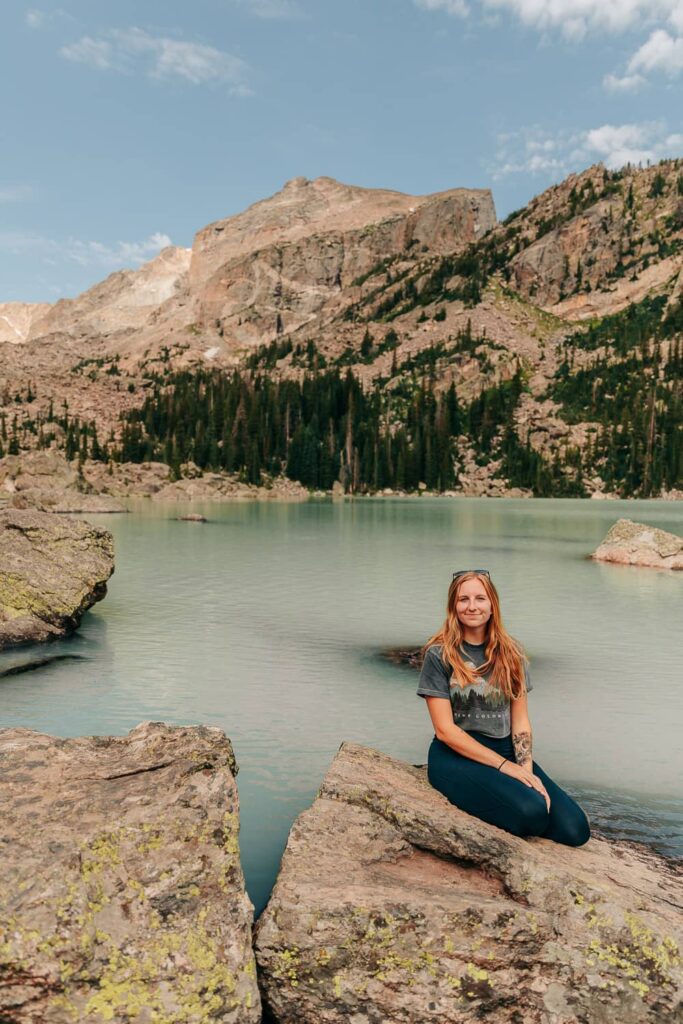
Bierstadt Lake
Length: 3 miles
Elevation Gain: 620 feet
Bierstadt Lake is a fun trail that combines steep elevation gain in the beginning, as you climb switchbacks with a view of the Continental Divide, with a beautiful loop around the lake at the top of the climb! Bierstadt Lake is unique in that it’s fed by snowfall and rainwater, but no streams flow in or out of the lake. The views of snow-capped mountains and lilypads on the water’s surface make Bierstadt Lake a gorgeous choice for a morning or afternoon hike.
The Loch
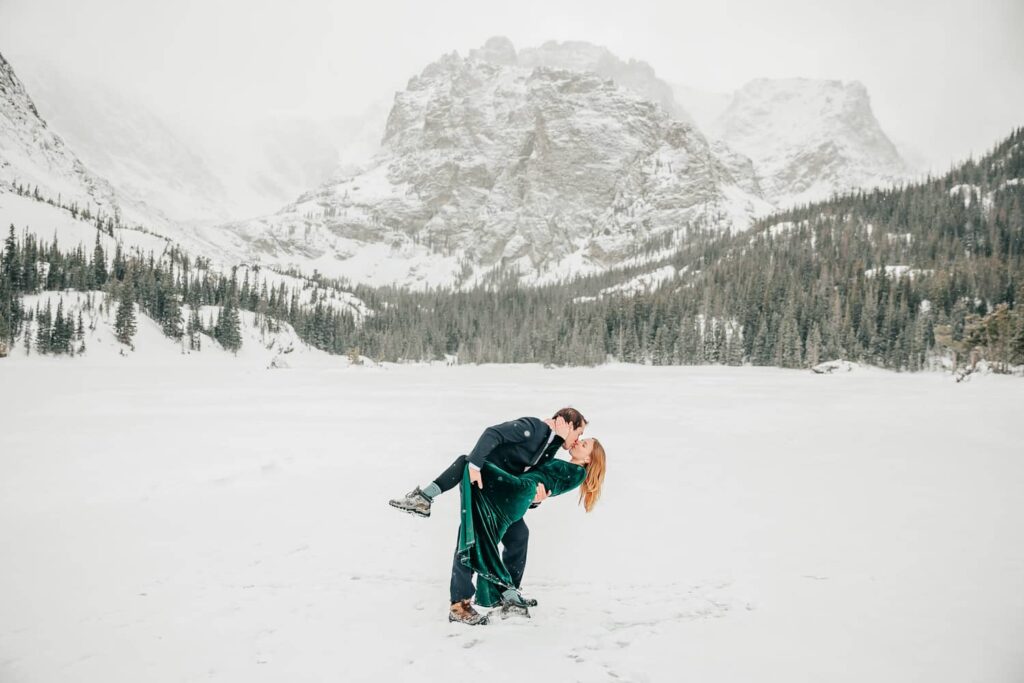
Length: 5.4 miles
Elevation Gain: 1060 feet
The Loch is a slightly more challenging hike with a higher elevation gain via switchbacks, leading to an incredibly scenic lake nestled between steep, rocky mountains. This hike is beautiful from beginning to end, leading you through aspen groves, across bridges, and into a striking gorge with glacier views.
You can combine this with Mills Lake if you want to hike a bit longer!
Mills Lake
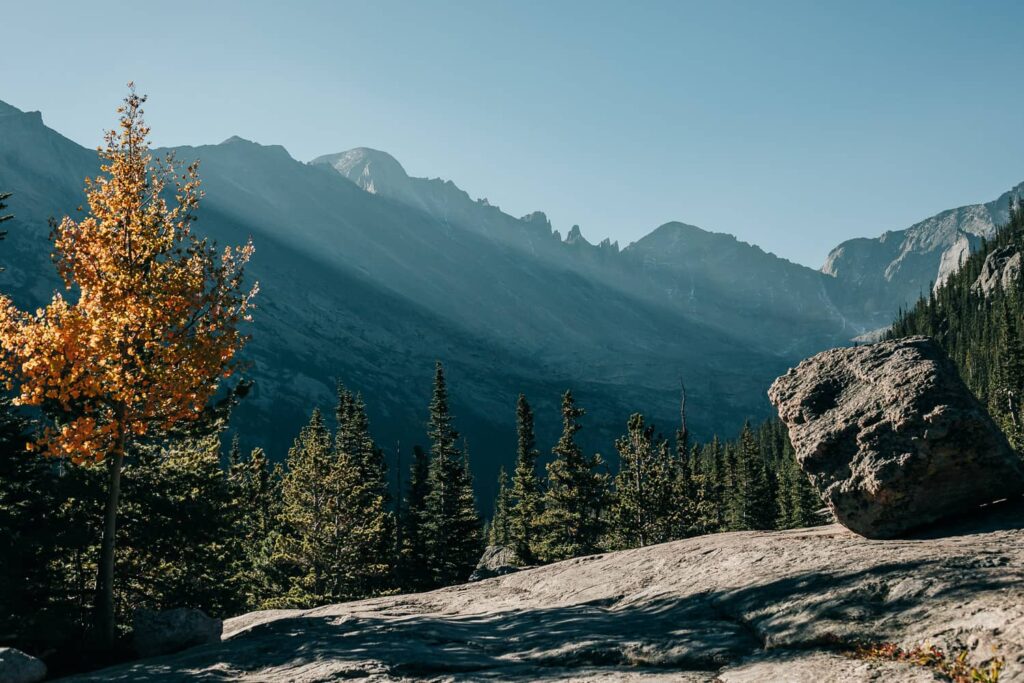
Length: 5.4 miles
Elevation Gain: 825 feet
Mills Lake begins at the same trailhead as the Loch and is an equally beautiful trail from start to finish, navigating past waterfalls, stream beds, and a gorge carved by glaciers. Mills Lake is a crystal clear alpine lake, and if you’re up for a greater challenge, there is an additional 1.7-mile, very steep hike from Mills Lake up to Black Lake.
Intermediate Hikes Outside the Bear Lake Corridor
If you’re looking for a slightly lesser-populated route for a partial-day excursion in Rocky Mountain National Park, these are some of my favorite intermediate hikes throughout the rest of the park!
Gem Lake
Length: 3.2 miles
Elevation Gain: 1000 feet
Gem Lake is a unique hike via the Lumpy Ridge trailhead leading to a stunning lake surrounded by huge granite formations. The fallen trees and stumps sticking out of Gem Lake only add to the unusual beauty of this snow-melt alpine lake. Gem Lake is also a particularly good option for a winter hike because the trail’s southern exposure and relatively low elevation mean it doesn’t receive the same intense snowfall of many other trails in Rocky Mountain National Park.
Ouzel Falls
Length: 5.3 miles
Elevation Gain: 1000 feet
Ouzel Falls is one of my favorite waterfall hikes in Rocky Mountain National Park! Ouzel Falls is an impressive waterfall cascading over a cliff and huge boulders. The trail also passes by several other waterfalls on the way, and once you reach the falls you can hike another 2.2 miles to Ouzel Lake, making this a great choice for a choose-your-own-adventure trail!
Longer Hikes in Estes Park
If you’re a more experienced hiker or looking to spend a whole day on the trail to reach some truly amazing places, there are so many longer (8+ mile) hikes to choose from. Keep in mind that it’s extra important to be prepared for the unpredictability of nature on a longer hike, especially with Colorado’s ever-changing weather, so don’t forget to read my tips on hiking preparedness below!
Sky Pond
Length: 8.6 miles
Elevation Gain: 1,770 feet
Sky Pond is my favorite longer hike in the Bear Lake Corridor! This challenging trail begins at the Glacier Gorge Trailhead and takes you past Chaos Creek, Alberta Falls, Loch Vale, Glass Lake, and countless peaks and glaciers. The path to Sky Pond includes a challenging rock scramble up Timberline Falls, so I would definitely recommend this to more experienced hikers and those without a serious fear of heights! However, the dramatic views at Sky Pond are definitely worth the trek, with sheer rocky cliffs surrounding the lake.
Finch Lake Trail
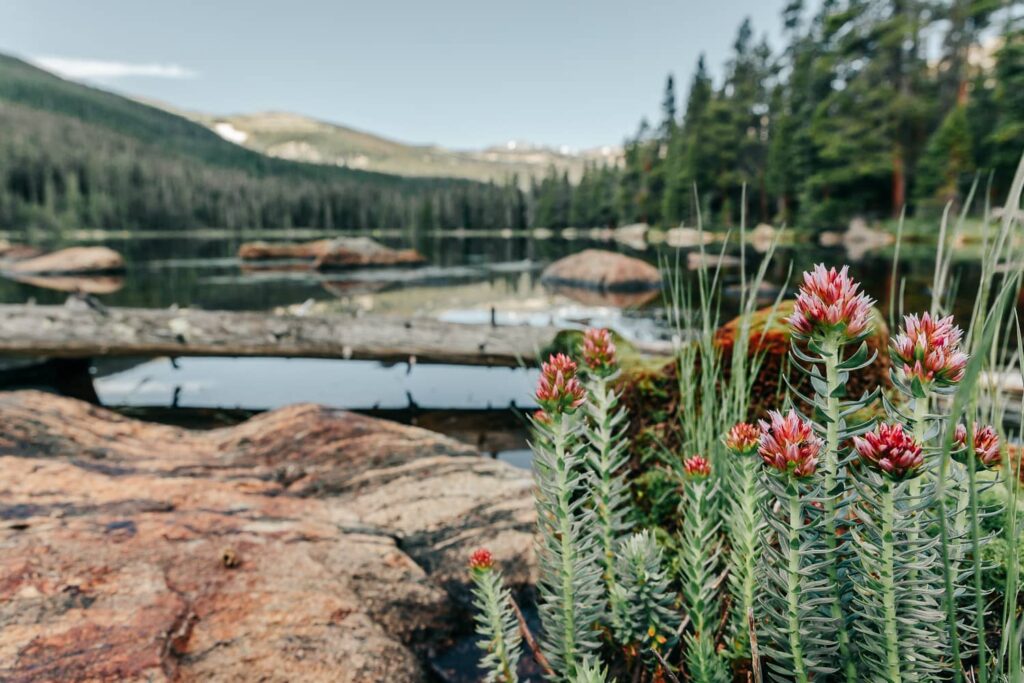
Length: 8.5 miles
Elevation Gain: 2,000 feet
One of two routes to Finch Lake, the Finch Lake trail is a moderately challenging trail beginning in the Wild Basin area of Rocky Mountain National Park. The trail begins with a sharp elevation gain and passes through beautiful forests and wildflowers to reach Finch Lake, which offers unmatched views of Ogalalla Peak and Mt. Copeland. Finch Lake is also a great location for spotting moose and deer!
Chasm Lake
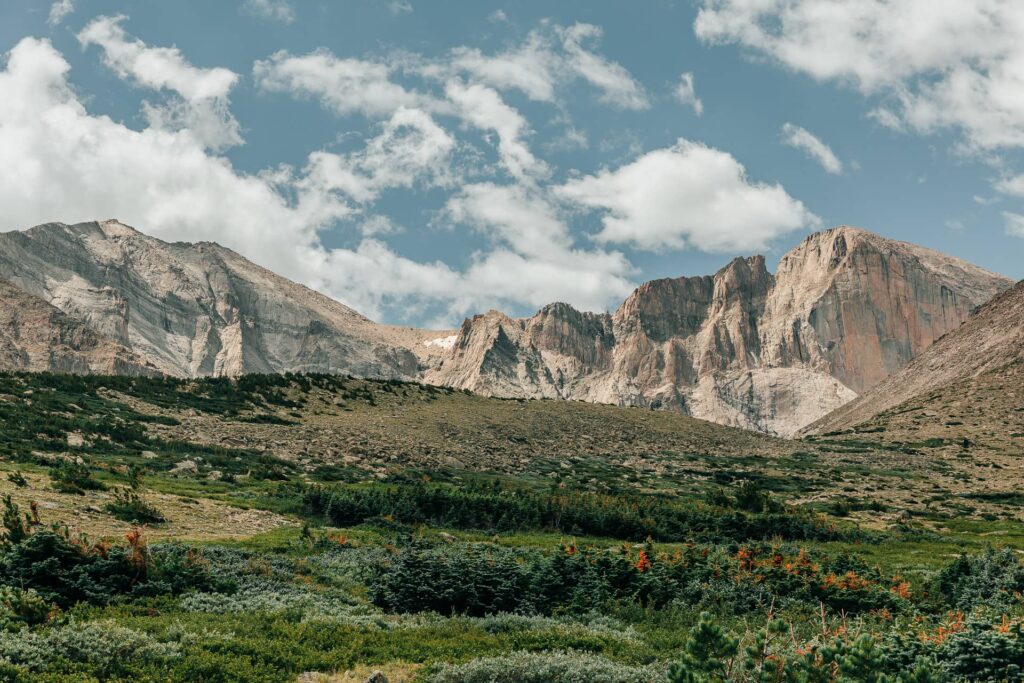
Length: 8 miles
Elevation Gain: 2,550 feet
The hike to Chasm Lake begins at the Longs Peak trailhead and follows the East Longs Peak Trail for much of the hike. With rocky passages and high elevation gain, I definitely recommend this trail to more experienced hikers, and a very early start time. However, the views of Chasm Lake nestled below the east-facing wall of Longs Peak make a dramatic and completely one-of-a-kind view that is well worth this more challenging hike.
Ypsilon Lake
Length: 9.5 miles
Elevation Gain: 3,000 feet
The hike to Ypsilon Lake, beginning at the Lawn Lake trailhead, starts with a steep hike through thick pine forest and takes you past the steep banks of the Roaring River before flattening out around Chipmunk Lake and continuing to Ypsilon Lake. Ypsilon Lake sits at the base of Ypsilon Mountain and is fed by a beautiful waterfall over mossy rocks. Because of the large elevation gain, this hike is best for experienced hikers who are used to elevation.
Pear Lake
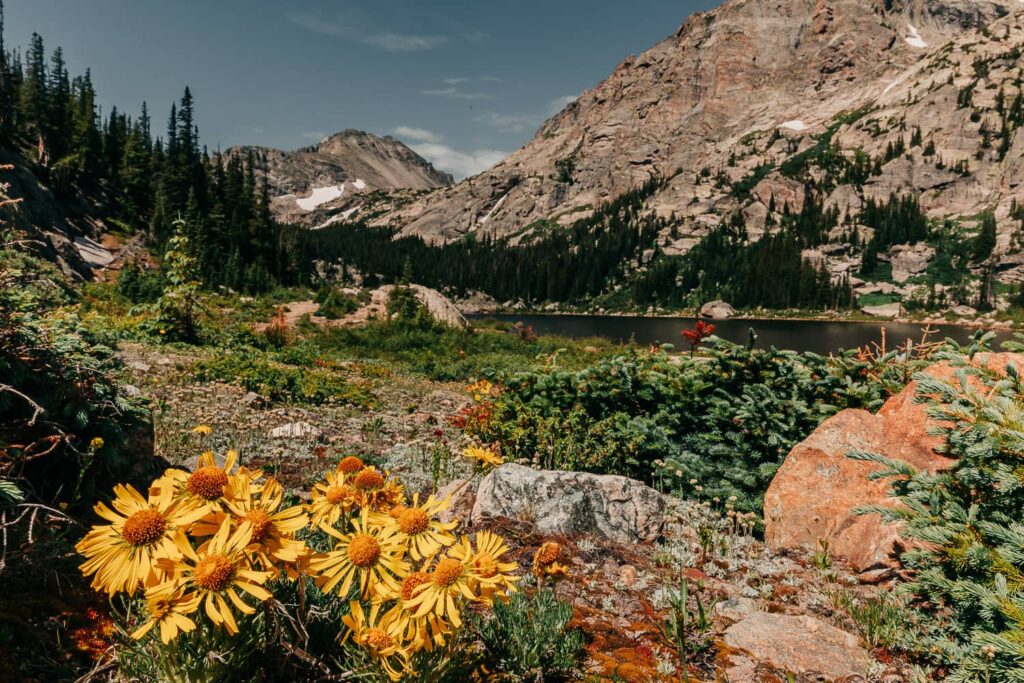
Length: 12.1 miles
Elevation Gain: 2,700 feet
One of my longest favorite hikes, Pear Lake is a great option for those with a whole day to hike who want to get away from the crowds of Rocky Mountain National Park’s busier areas and enjoy some pristine nature. The Pear Lake trail begins at the same trailhead as Finch Lake and crosses several streams to reach Pear Lake, which sits at the base of Mt. Copeland. This trail is another great option for spotting wildlife if you’re up for a strenuous trek!
Dog-Friendly Hikes in Estes Park
Unfortunately, Rocky Mountain National Park does not allow dogs on any of the trails in the park (though they are allowed in picnic areas and campgrounds on leashes). If you’re planning to bring your pups for hiking in Estes Park, you’ll have to look outside the national park for dog-friendly trails! Here are some of my favorite dog-friendly hikes around Estes Park.
Knoll-Willows Open Space
Length: 0.5 miles
Elevation Gain: none
For an easy walk or hike, or just to stretch your doggo’s legs, the Knoll-Willows Open Space is central to downtown Estes Park and offers a half-mile loop with the mountain views Estes Park is known for! You could even grab coffee at Kind Coffee, one of my favorite local Estes spots, across the street and take a stroll around this scenic nature preserve.
Kruger Rock
Length: 4 miles
Elevation Gain: 1,000 feet
Just a short drive outside downtown Estes Park, the Kruger Rock trail is a steep but dog-friendly route that takes you to the top of Kruger Rock, with an absolutely picturesque view of the whole Estes Valley. Because this hike is at a lower elevation than those in Rocky Mountain National Park, it’s also a great choice in the snowy season.
Lake Estes Trail
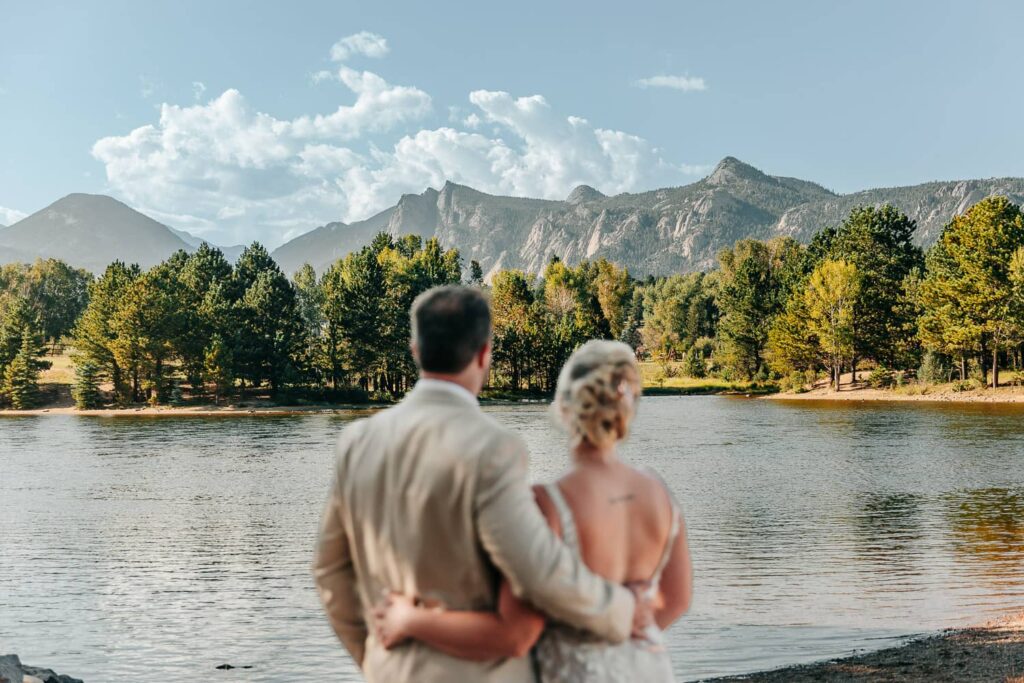
Length: up to 4 miles
Elevation Gain: 200 feet
The Lake Estes Trail is located right in the center of Estes Valley and is perfect for both dogs and families with kids. The whole loop is 4 miles long, but due to its central location you could easily walk only part of the loop. The trail is also very well-maintained and smooth, making it a good winter choice and a perfect option for those with limited mobility.
Permits for Rocky Mountain National Park
During the peak season (approximately May-October), Rocky Mountain National Park requires timed entry permits for the majority of the park between 9am and 3pm, and for the Bear Lake Corridor 5am to 6pm. Because many of the most popular areas and hikes are very busy during the summer, I highly recommend planning ahead to get a timed entry pass, especially if you’re planning a longer hike and want to start early in the morning.
You can reserve your timed entry pass here: https://www.recreation.gov/timed-entry/10086910
You can start reserving timed entry passes at 8am MT one month in advance (i.e., the passes for the month of July will become available at 8am MT on June 1). In 2023, Rocky Mountain National Park required timed entry passes for May 26 to October 22, and the park service has not yet released information about the 2024 season. You can check the rules for timed entry passes here: https://www.nps.gov/romo/planyourvisit/timed-entry-permit-system.htm
I highly recommend making an account for recreation.gov prior to the time the passes are released, and being on the website at 7:50am MT to be ready. The passes go fast! If you don’t get a timed entry, you can also try again the day before you want to enter. The park service releases some additional permits at 5pm MT the day before.
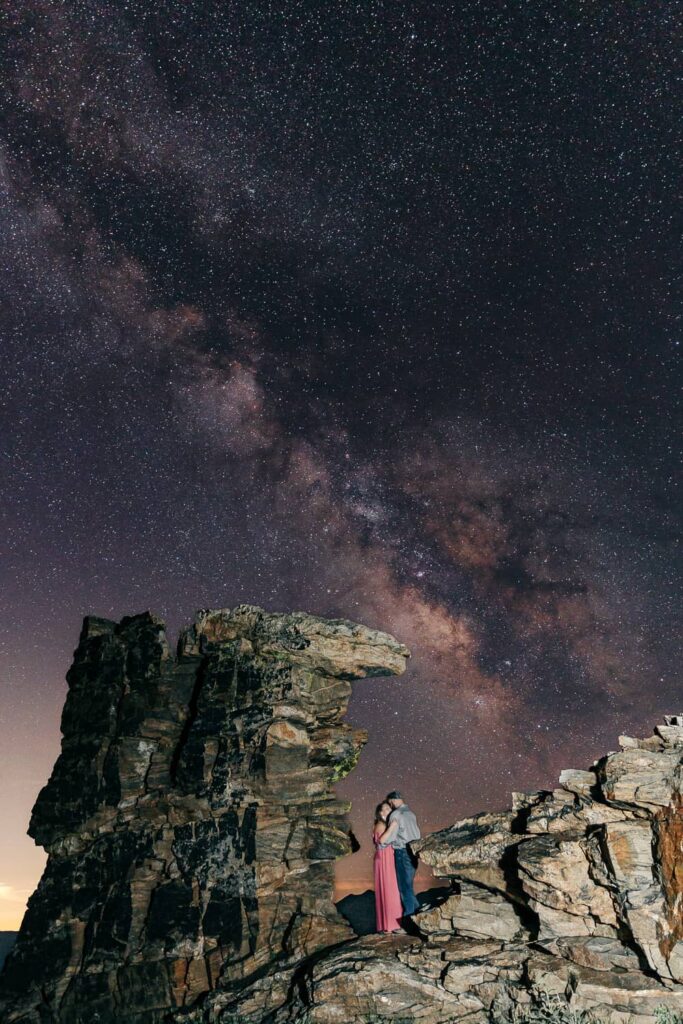
Timed entry costs $2 per permit, you only need one permit per car. If you do not get a permit, you can enter the majority of the park before 9am or after 3pm, or the Bear Lake Corridor before 5am or after 6pm.
No worries if you don’t get a permit. Go early, venture around the rest of the park, or explore after sundown. There’s still plenty of fun to be had in the park after dark!
Considering Weather for Hiking in Estes Park
Colorado is known for its unpredictable weather! Even in the summer, afternoon thunderstorms are common, and the weather can change on a dime. However, Colorado also has 300 days of sunshine a year, so you’re likely to get some sunshine at least during part of your day!
Here are my recommendations for considering weather when planning a hike in Estes Park:
- Check out average temperatures and weather conditions for the day of your hike. Weather.gov and Visit Denver have average high and low temperatures and precipitation for any day of the year.
- Check out trail conditions the day before your hike (and before you head out of service). Sites like AllTrails will include real-time weather reporting and descriptions from other hikers about the condition of the trail, including how much snow is on the ground and whether you need to consider spikes or snowshoes.
- Start early in the day. Afternoon thunderstorms are common in the summer, and lightning is a danger for high-elevation hikes. If you’re planning a hike to a peak or alpine lake, try to plan your hike to avoid being in an exposed, high-elevation area in the afternoon.
- Pack for weather. Make sure to pack supplies for any weather you may encounter, such as a rain jacket, snow spikes, or warm layers, and always bring extra snacks and lots of water. See my other tips below on how to pack safely for hiking in Estes Park!
How to “Leave No Trace” When Hiking
Estes Park and Rocky Mountain National Park have some of the most beautiful, pristine nature in the world, and it’s the job of every visitor to protect it for others to enjoy. The Leave No Trace foundation has 7 principles for leaving nature the way you found it:
- Plan ahead and prepare
- Travel and camp on durable surfaces
- Dispose of waste properly
- Leave what you find
- Minimize campfire impacts
- Respect wildlife
- Be considerate of others
When hiking in Estes Park, there are some specific things to consider when trying to leave no trace:
- Don’t feed or approach wildlife. Rocky Mountain National Park has tons of wildlife, from chipmunks and marmots to bighorn sheep and moose. Even though these animals are often cute and amazing to see in person, it’s important to remember that they are wild animals and can even be very dangerous. Give wild animals a wide berth, especially when it comes to animals like moose or bears that can pose a huge safety risk to hikers. Learn more about Rocky Mountain National Park’s abundant wildlife on the park service’s website.
- Pack out trash and waste. Make sure that anything you bring with you leaves with you! Be considerate of food wrappers, and make sure you dispose of any trash in the bear-safe trashcans at trailheads and picnic areas. Also, just because something like an orange peel may decompose eventually doesn’t mean you should leave it. Imagine if every visitor did that! The trails would be full of orange peels.
- Don’t take anything with you. Though it can be tempting, don’t remove any rocks, pinecones, flowers, or other natural objects from their natural environment. Only leave with memories and photos!
- Stay on established trails. The Rocky Mountain National Park rangers work hard to keep hiking trails maintained and safe and ensure hikers don’t wander off and potential damage the nature around them. Make sure to stay on established, marked trails and paths—don’t trample meadows or tundra to get a better view, as these environments are home to all kinds of fragile ecosystems and creatures.
Estes Park Hiking Safety
Estes Park is one of the most beautiful—and my favorite—places on earth, so much so that it can be easy to forget how dangerous that incredible nature can be! Apart from weather risks, there are dangers posed by wildlife, heat and cold, and treacherous terrain that are important to keep in mind when planning an Estes Park hike.
Here are some guidelines to keep in mind when planning and embarking on a hike in Estes Park:
- Know your limits. Don’t overestimate how long or strenuous a hike you can accomplish, and make sure you’re considering how the high elevation of Rocky Mountain National Park can humble even experienced hikers. Plan extra time so you can take breaks as needed. It’s always ok to turn around early and try again another time.
- Leave a trip plan. Make sure a friend or family member (who is not with you) knows when and where you’re planning to hike in case anything goes awry.
- Be mindful of weather conditions. Make sure you’re checking weather conditions before you embark on a hike (more above), and pack for whatever the day may throw at you. Shoe spikes and snowshoes are often necessary for winter hikes and snow-covered trails, and a packable rain jacket is always a good idea, even in the summer. Keep in mind that temperatures in Rocky Mountain National Park can be extreme regardless of the season, so layers are often a good move.
- Bring adequate food and water. Especially because Estes Park is at such a high elevation, adequate water is an absolute must when hiking. You’d be surprised how strenuous even a 4-mile hike can be when you take into consideration the elevation of the park and the hike’s elevation gain. It’s always better to be overprepared than underprepared in this regard! Snacks are also key to keep you energized and fueled.
- Get your supplies in order. In addition to food and water, make sure you have the other supplies for a successful hike:
- Backpack
- Water bottle(s)
- Sturdy hiking shoes and socks (no flip flops or converse)
- Jacket and hat
- Bug spray and sunscreen
- First aid kit
- A map
Have You Considered a Hiking Adventure Session or Estes Park Elopement?
A hike in Estes Park can be the perfect place to capture your love, whatever stage it’s at! I know all the best spots for adventure sessions, family portraits, proposals, and even elopements in Rocky Mountain National Park and throughout Estes Valley, and I’d love to help bring your dream to life.
If you’re planning a trip to Estes Park and want to document a fun-filled vacation, I can help you plan an adventure session of amazing photographs that are true to you as a couple (or family)!
If you want to propose to your partner at one of the many picturesque lakes I mentioned above, reach out to me! I can help you pick the perfect location and timing, taking into account hike difficulty, weather, lighting, and every other consideration.
And if Estes Park is your dream elopement destination, fill out my contact form and let me help you plan the perfect intimate ceremony with a mountain backdrop you just can’t find anywhere else! You can read my blogs about the best time to elope in Colorado and a particularly gorgeous elopement at Lily Lake in Rocky Mountain National Park for more information.

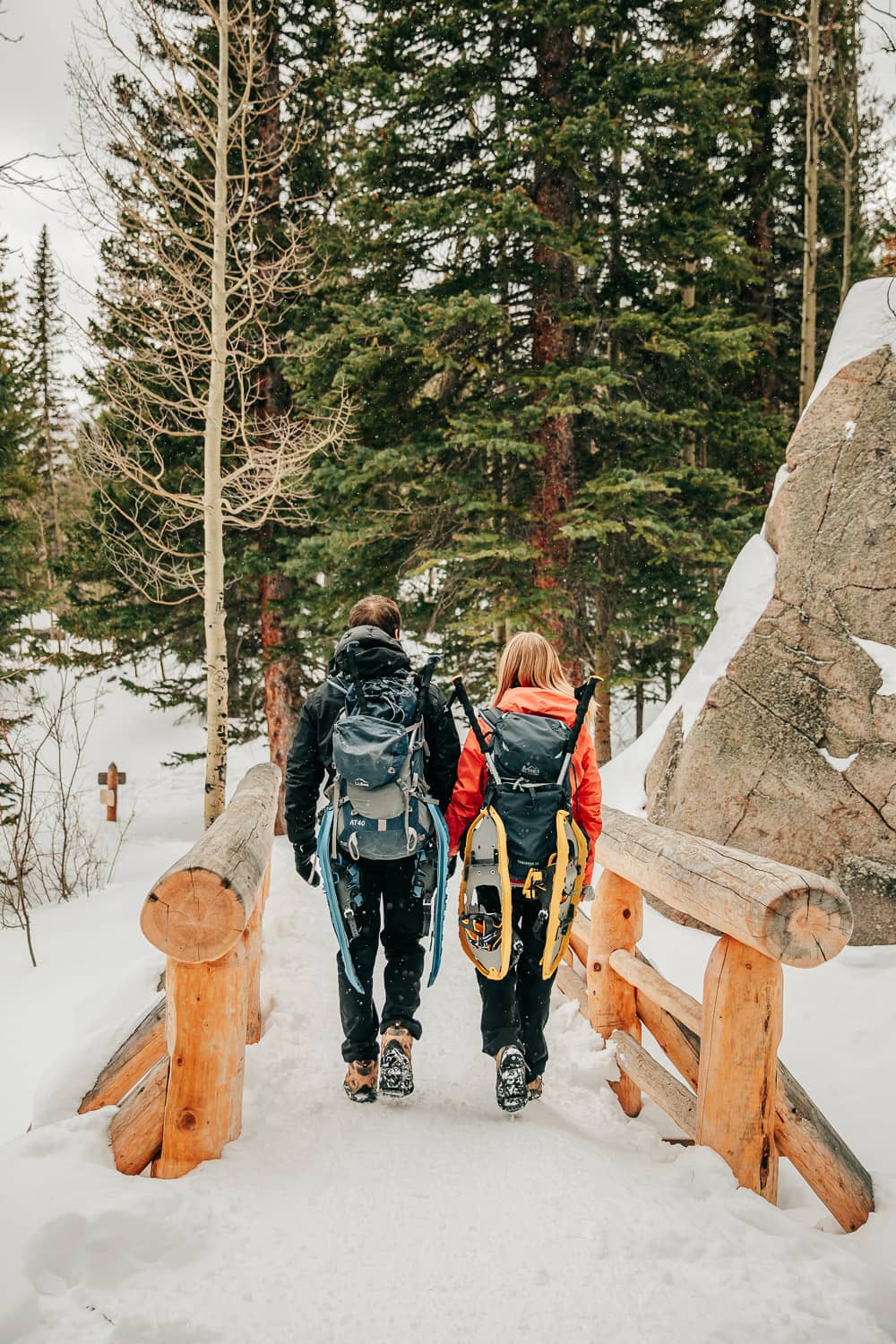
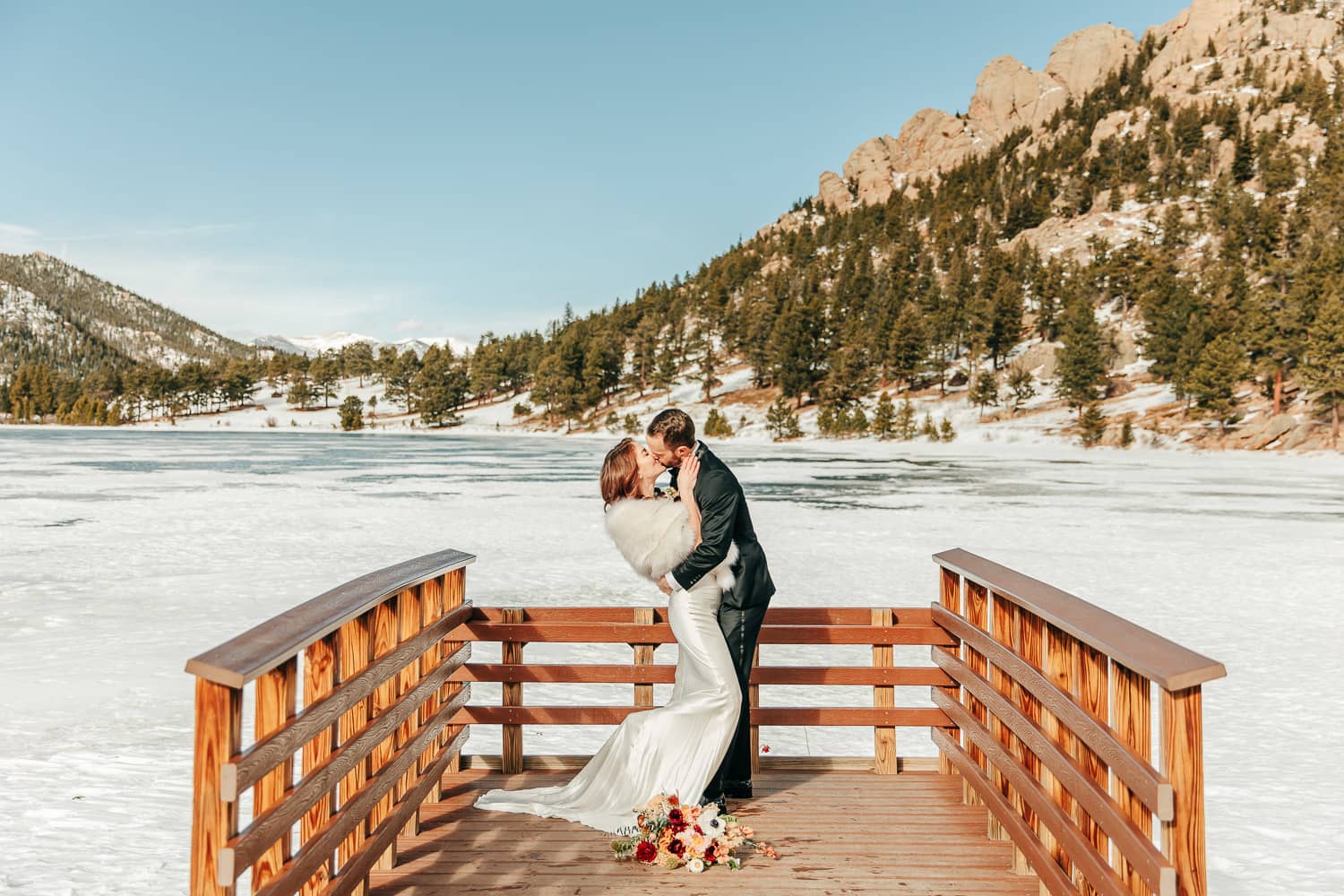
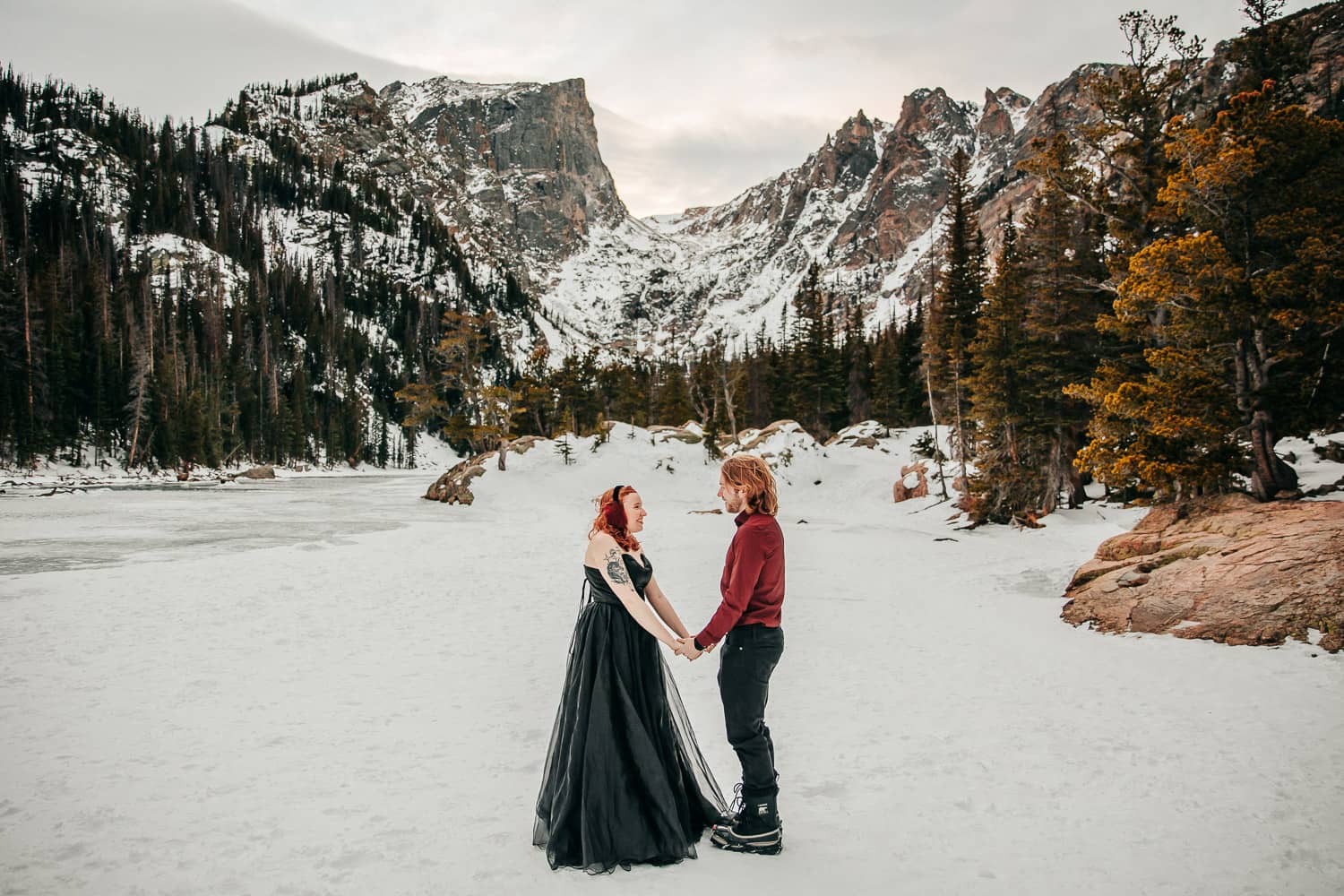

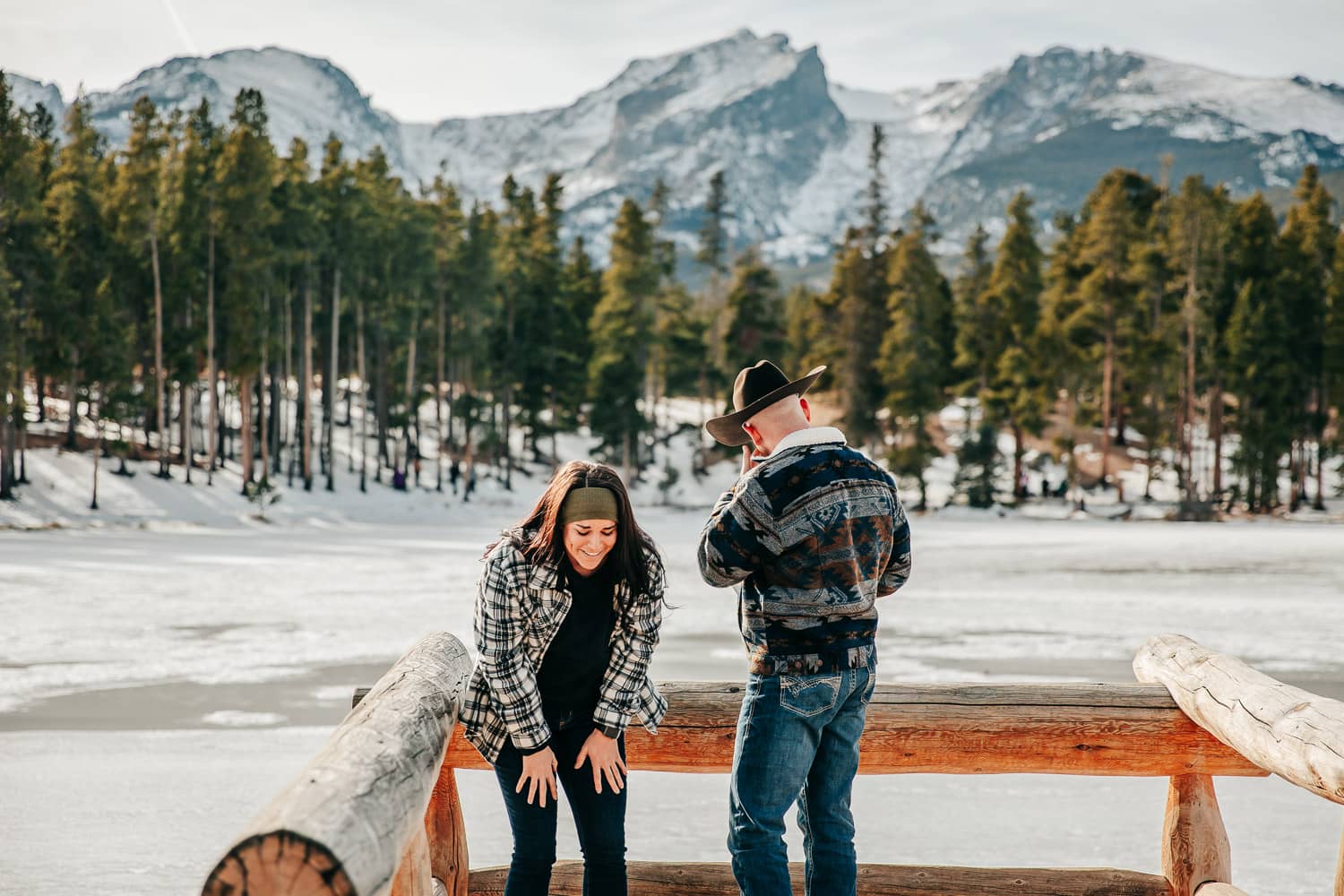

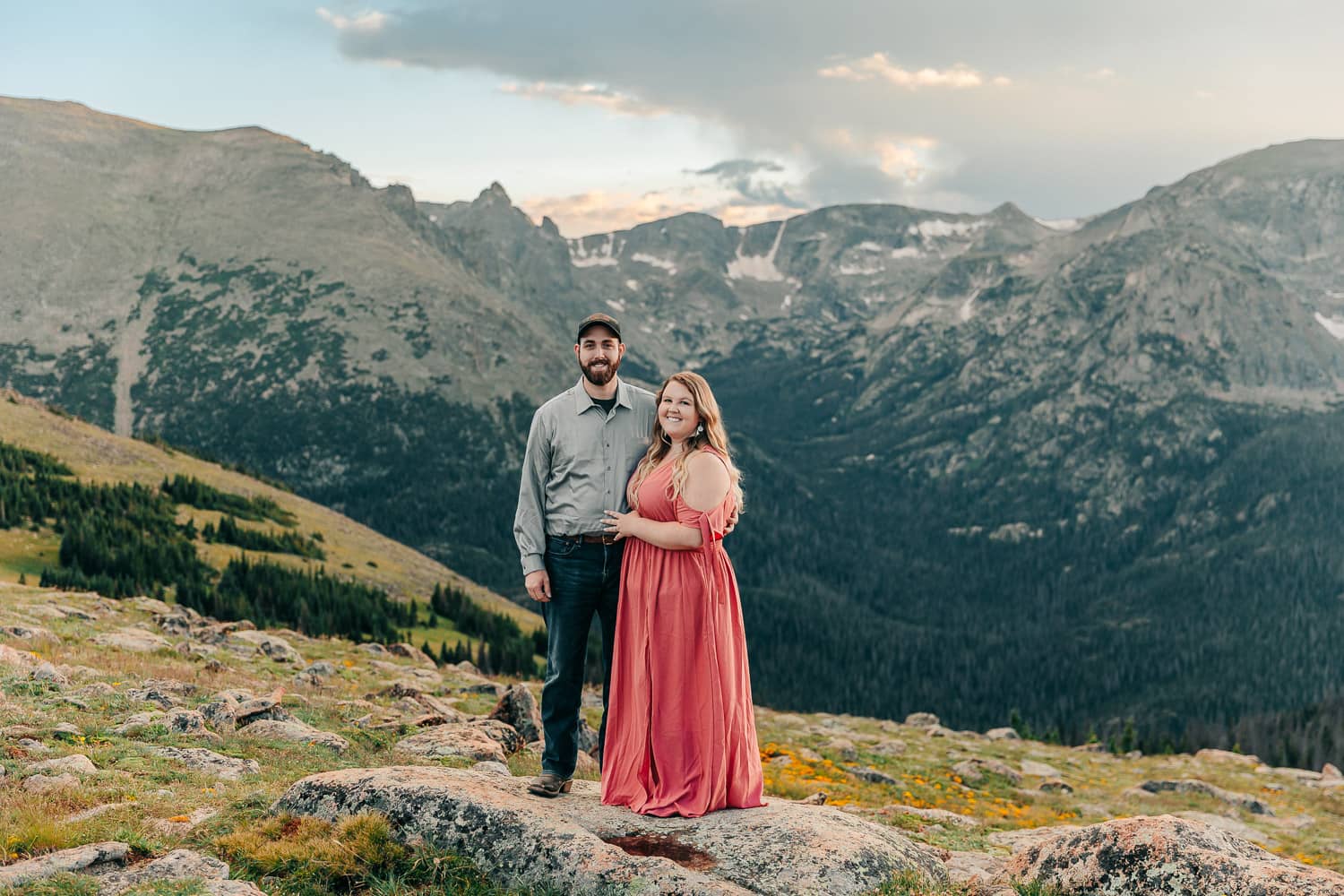
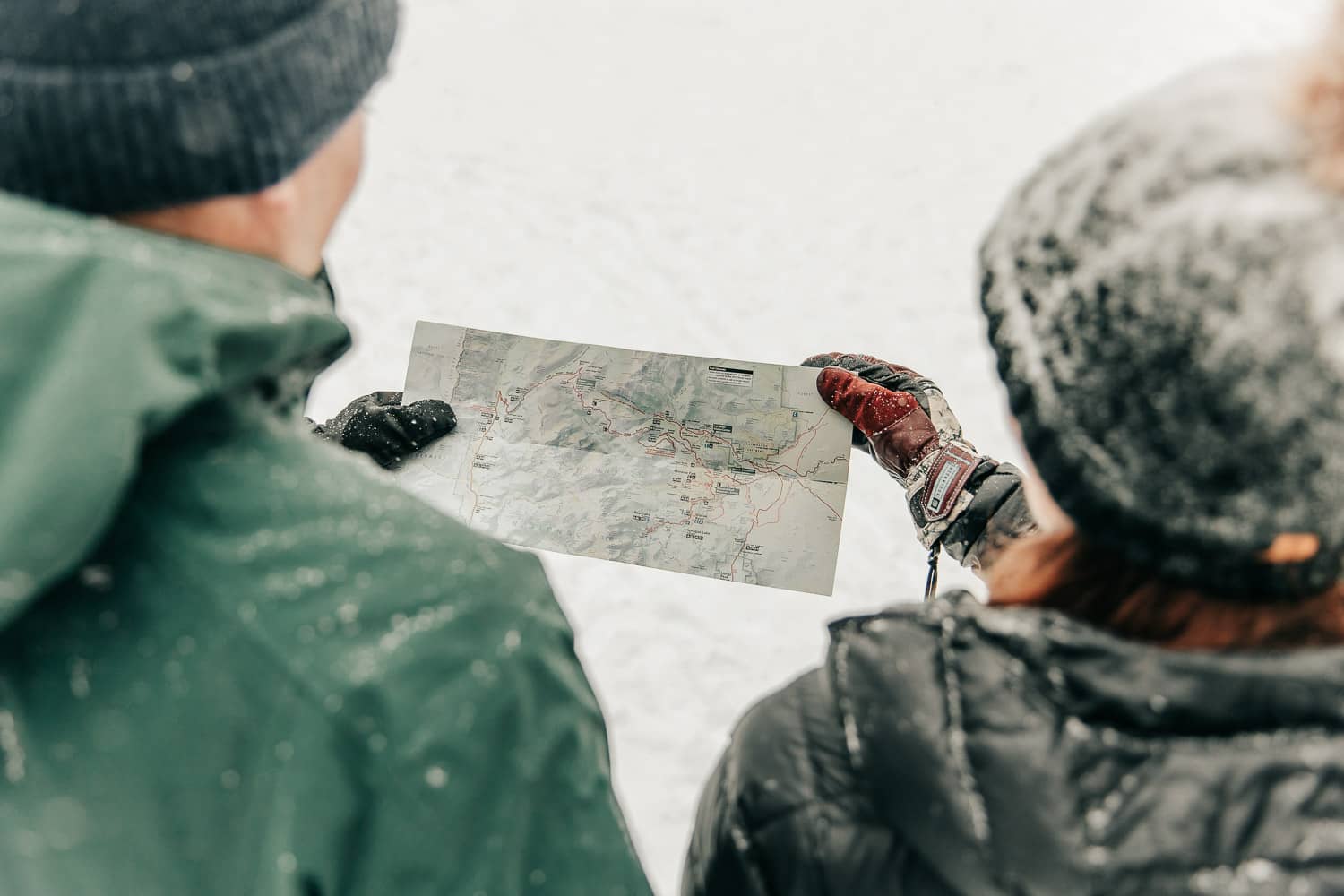


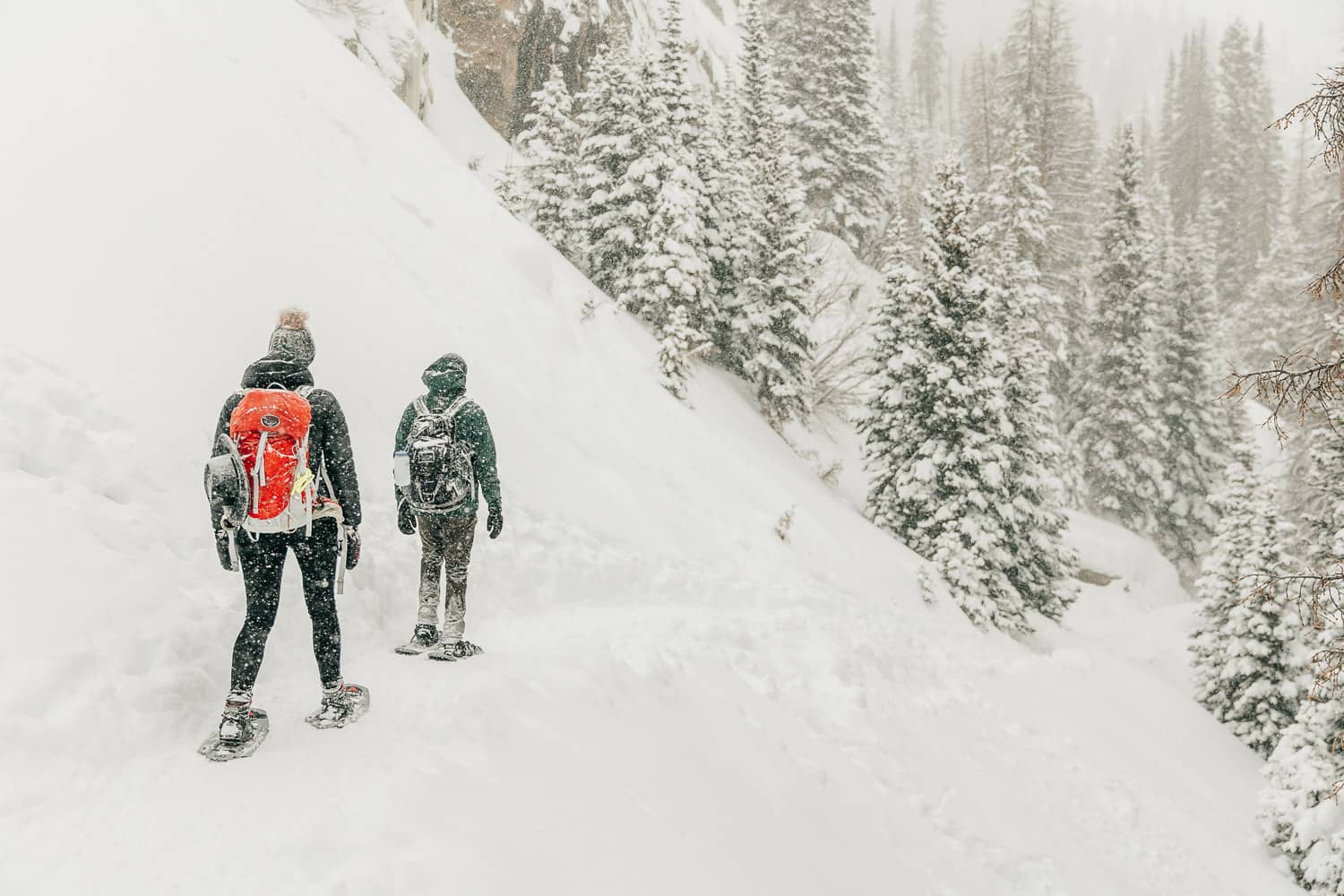


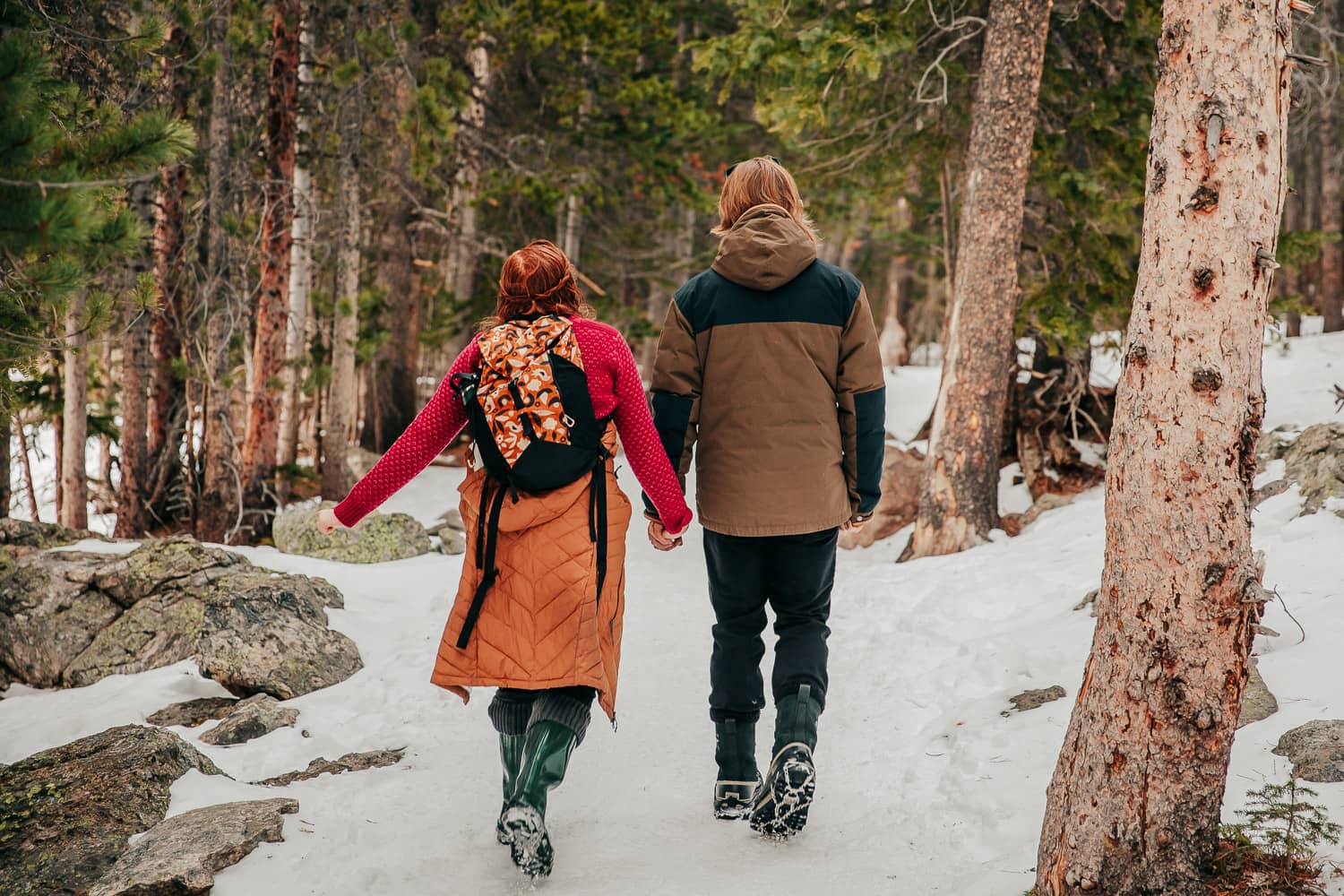
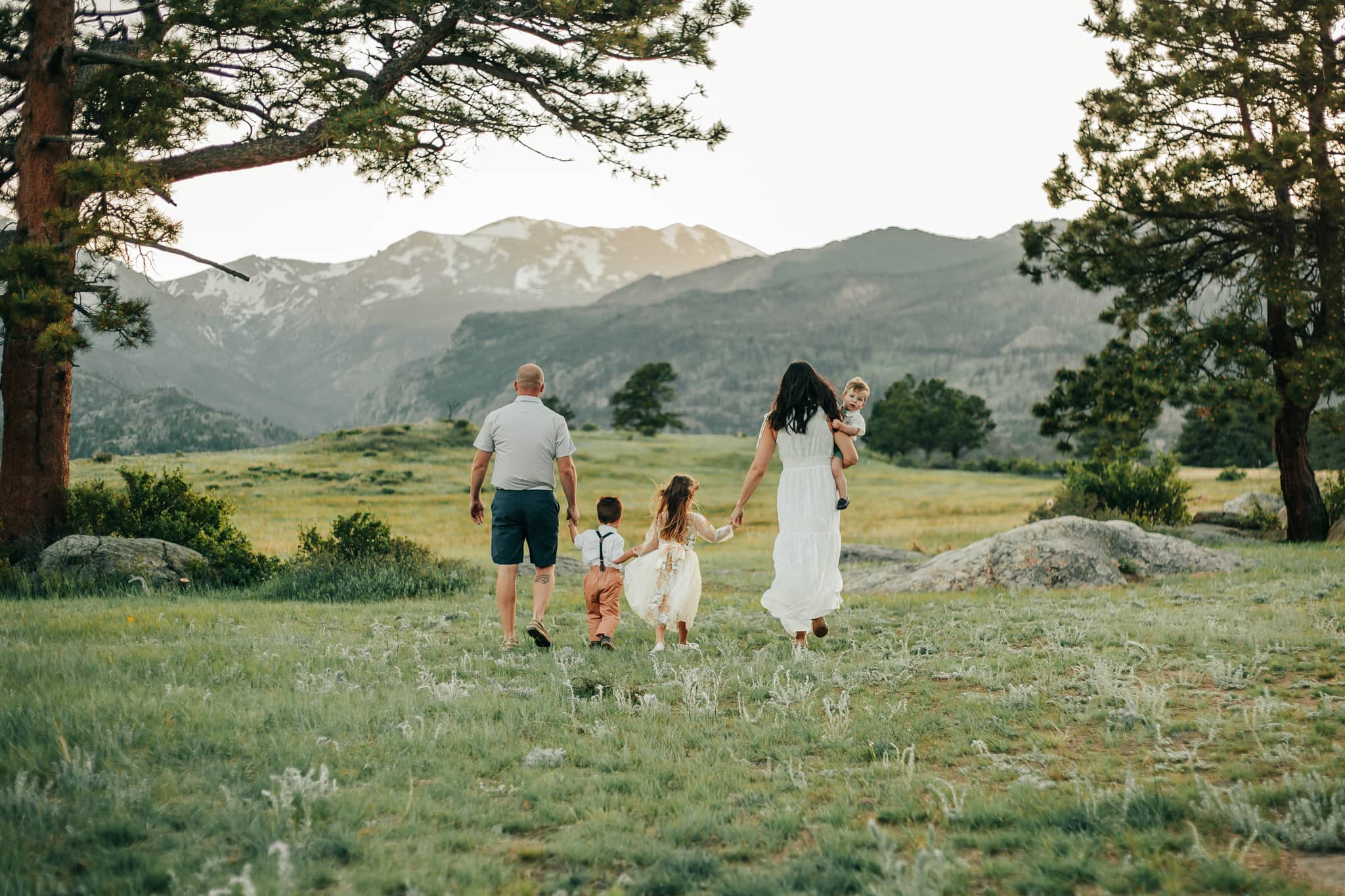


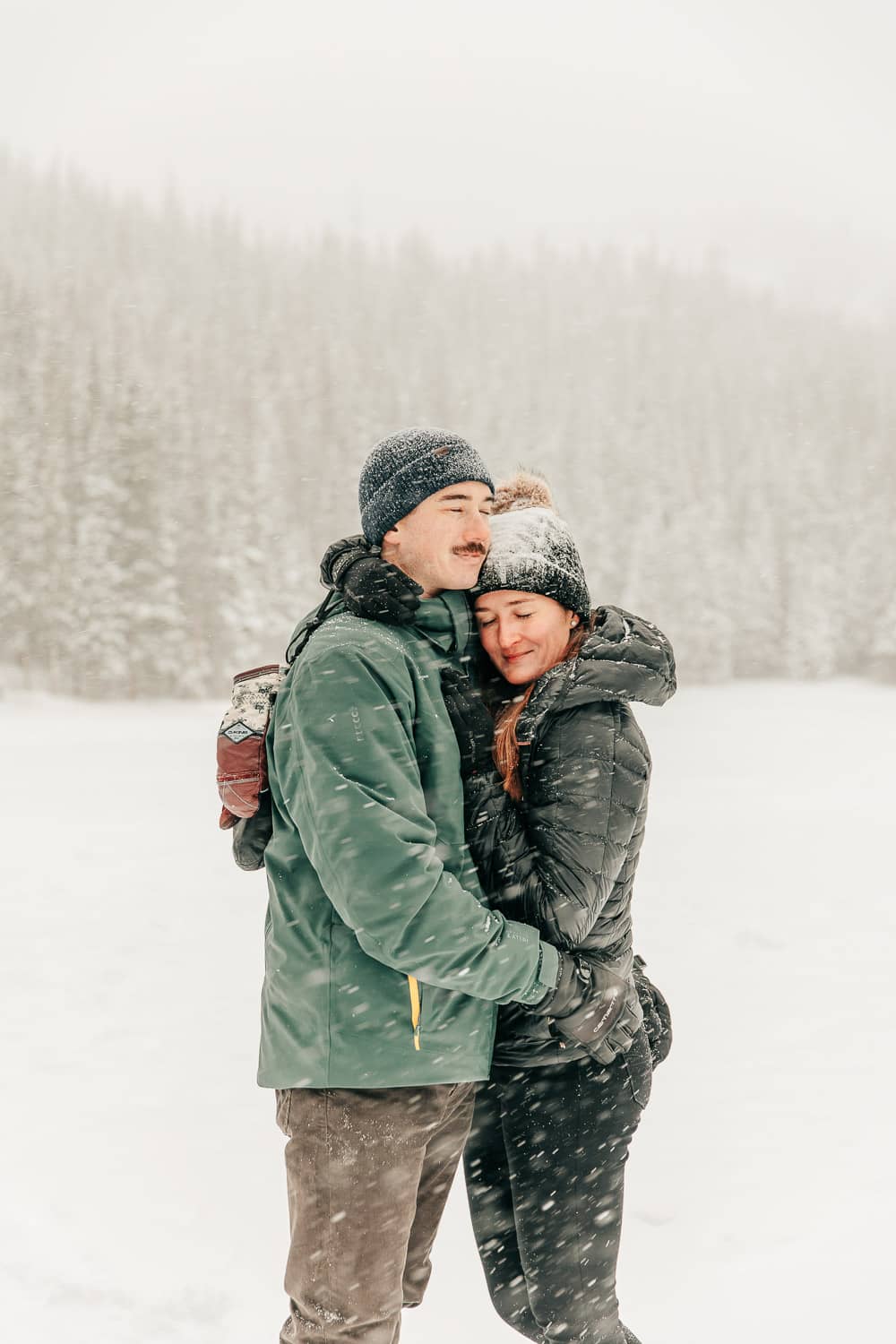
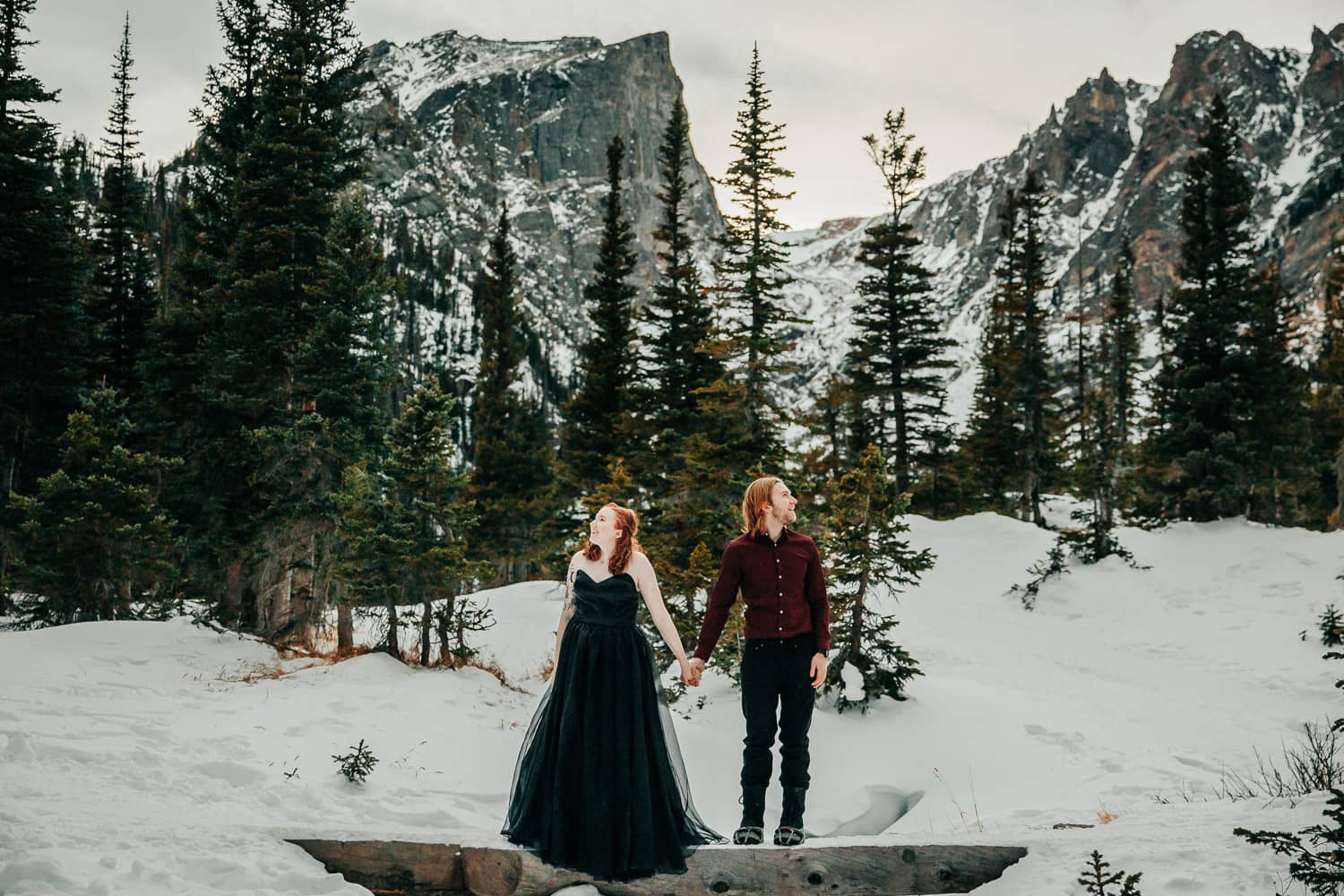
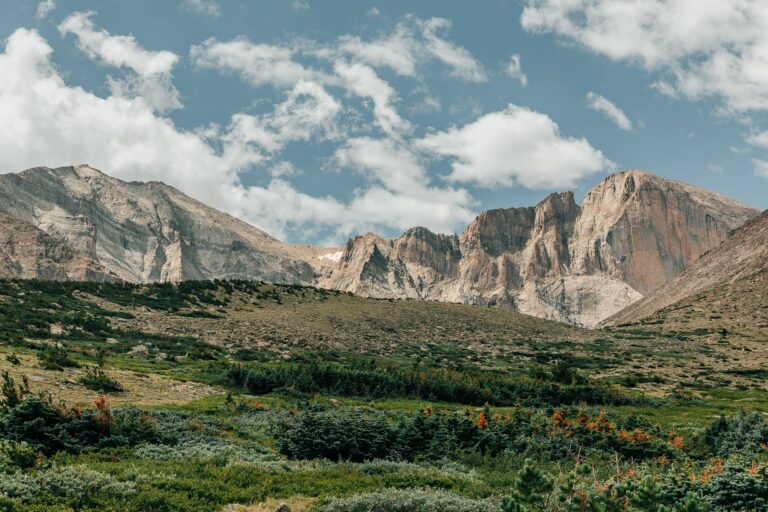
Such a helpful guide and beautiful pictures! I haven’t heard of some of these hikes before, and those hidden gems are perfect for escaping the crowds!
Thank you! I definitely recommend something like Pear Lake if you want to escape the crowds. But, I also have a few secret spots up my sleeve if you want privacy for photos!